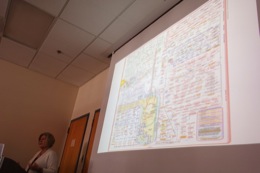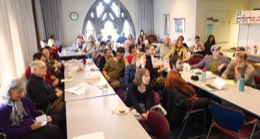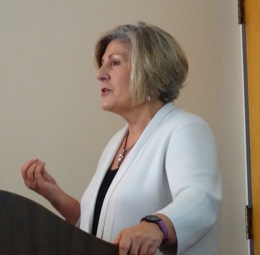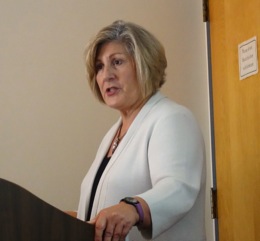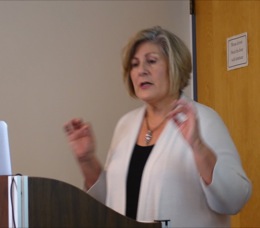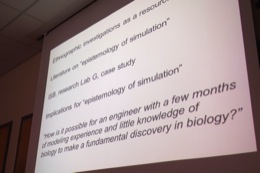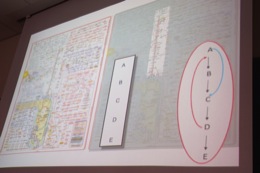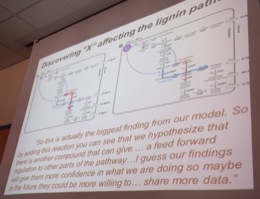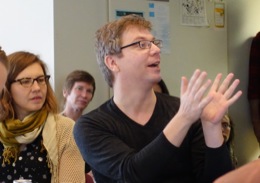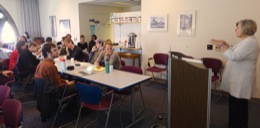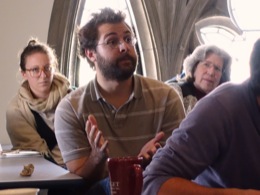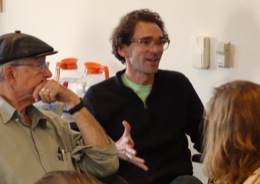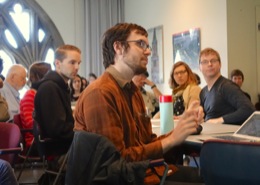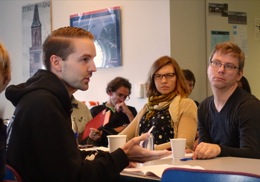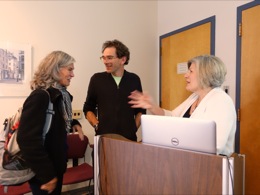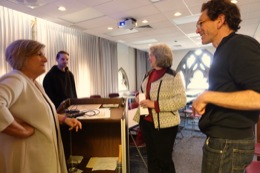

![]()
home
::: about
::: news
::: links
::: giving
::: contact
![]()
events
::: calendar
::: lunchtime
::: annual
lecture series
::: conferences
![]()
people
::: visiting fellows
::: postdoc fellows
::: resident fellows
::: associates
![]()
joining
::: visiting fellowships
::: postdoc fellowships
::: senior fellowships
::: resident fellowships
::: associateships
![]()
being here
::: visiting
::: the last donut
::: photo album
|
Managing Complexity Introducing Nancy Nersessian, our Senior Visiting Fellow, is a difficult task. The problem is that she is very accomplished; and she is justifiably proud of her accomplishments. That achievement must be captured in a few words. I begin, unfazed by her modest call that I should not take away from her speaking time. I recount her appointments at Princeton; then Georgia Tech, where she rose to a Regents’ Professorship; and her present affiliation with the Harvard Psychology Department. I manage to mention her three books, two of which have won awards and a third that has been translated into Chinese. Finally there is the unexpected fact that she is an opera singer. Somewhere in all that I managed to squeeze a giggle from the room. Looking over the room, it was comforting to see that the talk was well-attended. It was a “good house” as we like to say in the business. That was far from assured. Over dinner the night before, Nancy had confessed her worry to me. Her talk had ended up in direct conflict with the 30 year anniversary celebration of the Philosophy Department at neighboring Carnegie Mellon University. Would that not bleed her audience, especially of senior faculty, who might be drawn away either by interest or obligation? After I took my seat, I noted with pleasure that the room continued to fill. While the talk progressed, more people came, filling the small entrance hall, before they found seats in the room. (I later quipped to Nancy that our colleagues across Panther Hollow would be regretting their misfortune in being scheduled against this talk!) Nancy has the floor at last; and that is good, since she has a lot to say. Her topic will be computer modeling in integrative systems biology, eventually. This was the topic advertised in the intriguing abstract accompanying her talk. There is a lot more that will be in the talk, however. In her research, Nancy uses ethnographic methods. That is, she embeds herself amongst the scientists whose work she studies. She watches and gathers data, copiously. These methods and the different communities she studies are part of the bigger story. It is an integrated story. One cannot understand one part without grasping the whole. Or, perhaps, one cannot have a really deep understanding unless one grasps all the parts. Conveying that deeper, fuller, richer understanding is Nancy’s goal. The talk began with a recounting of these methods, a defense of them and the encouragement to use them. They are complex, as is the integrative systems biology of the science itself. Nancy clearly loves the complexity and revels in the details. They are all loved and admired individually; and then filed away in some magnificently orderly scheme in the many corners of her mind. That is a capacity I admire, since I will admit to you here that I do not possess it. In fact, I am starting to become overwhelmed. I do not manage complexity well and I am not managing this complexity well. Fortunately I learned long ago how to survive when overwhelmed by complexity: pick the most important thread and ignore the rest. Having read the abstract, I knew that epistemic issues in modeling were coming. There is only so much concentration I have for a talk. I waited and saved my concentration for those issues. Nancy was tense when the talk started. There was, she knew, a lot to cover and little time in which to do it. She stood solid and immovable at the podium, working through her notes. My early photos were sharp. As the talk proceeded and point after point was delivered well and welcomed by the room, she relaxed. Her body language opened and she began to move more and make larger gestures. My photos became correspondingly less sharp. The topic now turned to computer simulations. There is a philosophical problem here. She called it “the epistemology of computer simulations.” In my simple rendering, it is just this: A computer simulation is merely a computer juggling a lot of symbols. Why should anything that comes out of it have credibility? Why should those results tell us about what is factually in the world? Nancy recalled the standard answer in the literature. In traditional contexts, such as in physics, computer simulations are driven by theories. We have learned the truth of the theories by detailed investigations of nature. Those theories deliver equations whose solutions are the product of the simulations. That product has the epistemic authority of the theories from which it is derived and the particular facts added to aid in determining the solutions. That is the simple version of the standard answer. The reality is a little more complicated. We pass from the theory to models and then on to the simulations. We hope that the methods used in these transformations have not corrupted the factual grounding of our starting point. Now comes the puzzle. In integrative systems biology, we do not have background theories and laws of comparable scope that can factually underwrite our simulations. Yet these simulations are still producing factual results of great utility. And they do so in the hands of computer engineers with a meager knowledge of biology. How can this happen? More sharply: “How is it possible for an engineer with a few months of modeling experience and little knowledge of biology to make a fundamental discovery in biology?” Nancy has a good answer, but first, there is more complexity. Modeling in systems biology is not a simple matter. It is a collaboration between biologists, who know the science, and modelers, who are adept at the computing. The successful simulations result from an elaborate, complex interaction among the members of these two groups. Nancy is quite eager to share that complexity with us. The details are intriguing and one could easily exhaust oneself following all the twists and turns. I kept my focus on the epistemological problem. That is the one that interests me. I will not walk you through the complex pathway that leads to the answer. That the modelers and the biologists interact dynamically is a big part of it. Let me just state the answer here, perhaps in oversimplified form. It has two parts: First, there are no laws giving details of the myriad of mechanisms that combine in biological systems. Rather, at a higher level of description, there are simplified processes identifiable that can be responsible for much of the system’s behavior. That is a profound and hard-won fact about these complex systems. Fortunately for the modelers, these same processes can appear in quite disparate systems. Modelers collect these processes in some abstract form and have them ready to apply to a new problem. They might be used successfully to model yeasts one day. The next day, they can be used to simulate cancer. Modelers who knows little biology might nonetheless have just the process on their shelf that does the trick for some new problem in biology. Here’s the simplification depicted visually. We start with this: We end up with this: Second, traditional simulations are created in a simple two step process. First the relevant theory is delineated. Then it is developed, through various stages, into the simulation. The development may be complicated, but the prior theory is unchanged. It is otherwise with integrative systems biology. The simulations are created in an iterative process. It starts with a rudimentary model, whose results are compared with the data. The processes employed are then adjusted and augmented and the performance of the modified simulation checked. The process is iterated and, when all goes well, the simulation evolves to a good fit with the data. It is a successful simulation. These two parts combined solve the epistemic problem. A computer modeler who knows little biology can play a role in the iterations that eventually lead to a successful simulation. Nancy has a striking example. Lignin is the polymer that gives wood its substance. It is a stable and robust material. When we use wood to build our chairs and houses, we are grateful for that stability. However when we want to use lignin as a feed for a biofuel, we are not. We want to break down the lignin into smaller components. The problem is to find the chemical pathways that enable this breakdown. Nancy described simulations that sought these pathways. They started with received accounts of the pathways and, as the simulations proceeded, found that they needed to adjust these received accounts. The most striking adjustment was the recognition of an unknown factor “X,” outside the standard pathways. If I followed the story correctly, this X was subsequently identified and was a triumph for the modelers. Or perhaps the triumph was merely that simulations produced such a prediction. The talk concluded and we took a short break before question time. The room had been quite filled for the talk and, I noticed with pleasure, that it stayed almost as full for question time. That is also when I found out that the talk had attracted people from biology who did not otherwise know of us. I talked with one academic who, she said, did exactly the mediation work between modelers and biologists described by Nancy. Another identified himself as coming from computational biology. The questions were spread over many topics and I will not try to capture the sweep here. However I do think that a persistent theme was just my concern: the epistemic problem. How is it that modelers without biological knowledge can produce factual and useful results? When my turn came, Nancy affirmed the all-too-simplified account I gave above. Or at least the politeness of question time prevented her telling me too forcefully that it really is a lot more complicated. John D. Norton
|
